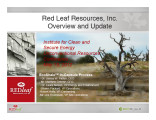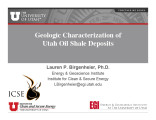TO
Filters: Research Institute: "Institute for Clean and Secure Energy (ICSE)" Collection: "ir_eua" Format: "application/pdf"
| Title | Date | Subject | Description | ||
|---|---|---|---|---|---|
| 101 |
 |
Oil recovery from a Utah tar sand deposit by in situ combustion | 1978-06-06 | The U. S. tar sand resource consists of an estimated 30 billion barrels (4.7Gm^3 ) of oil. Most of this resource is in six large deposits in Utah. Through research and development to prove tar sand oil recovery methods, the Department of Energy is attempting to stimulate commercialization of this re... | |
| 102 |
 |
Red Leaf Resources, Inc. overview and update | 2012-05-15 | EcoShale; Red Leaf; oil shale; oil extraction | Founded in 2006, Red Leaf Resources, Inc. is a privately-held Delaware corporation based in Salt Lake City, Utah focused on: the production of high-quality oil extracted from oil shale resources, the expansion of its resource portfolio, the licensing of its oil shale extraction technology, the EcoSh... |
| 103 |
 |
Geologic characterization of Utah oil shale deposits | 2010-04-28 | oil shale development; geologic framework; lake evolution; oil shale; stratigraphic correlation | Why Geology? Economic prospectivity of oil shale development in the Uinta Basin relies heavily on establishing a solid geologic framework. Understanding lake evolution matters. |
| 104 |
 |
Quarterly Progress Report Phase 3: Clean and Secure Energy from Coal - July 1, 2012 to September 30, 2012 | 2012-10-01 | domestic coal resources; CO2 capture; ICSE; Oxy-Coal | The University of Utah is pursuing research to utilize the vast energy stored in our domestic coal resources and to do so in a manner that will capture CO2 from combustion from stationary power generation. The research is organized around the theme of validation and uncertainty quantification throug... |
| 105 |
 |
Oil impregnated carbonate rocks of the Timpoweap Member Moenkopi Formation, Hurricane Cliffs area, Utah and Arizona | 1979 | Oil impregnated rocks; Hurricane Cliffs; Utah; Arizona; Timpoweap Member; Triassic Moenkopi Formation; Timpoweap Canyon; Hurricane, Utah | Oil impregnated rocks crop out at several localities near the Hurricane Cliffs in southwestern Utah and adjacent Arizona. The most significant petroliferous deposits occur in the Timpoweap Member of the Triassic Moenkopi Formation in Timpoweap Canyon and the Hurricane Cliffs south of Hurricane, Utah... |
| 106 |
 |
Oil and gas evolution kinetics for oil shale and petroleum source rocks determined from pyrolysis-TQMS data at multiple heating rates | 1991-11 | Evolution kinetics; Oil shale; Petroleum source rocks; Pyrolysis-TQMS data; Programmed-temperature pyrolysis; Triple-quadrupole mass spectrometry; Hydrous pyrolysis | Seven oil shales and petroleum source rocks were subjected to programmed-temperature pyrolysis at heating rates of 1 and 10 °C/min using triple-quadrupole mass spectrometry to monitor volatile compound evolution. Kinetic parameters were determined for evolution of hydrocarbons and various heteroato... |
| 107 |
 |
Oil and gas evolution kinetics for oil shale and petroleum source rocks determined from pyrolysis-TQMS data at two heating rates | 1992-04 | Volatile compound evolution; Oil shales; Petroleum source rocks; Programmed-temperature pyrolysis; Triple-quadrupole mass spectrometry; Hydrous pyrolysis | Seven oil shales and petroleum source rocks were subjected to programmedtemperature pyrolysis at heating rates of 1 and 10 °C/min using triple-quadrupole mass spectrometry to monitor volatile compound evolution. Kinetic parameters were determined for evolution of hydrocarbons and various heteroatom... |
| 108 |
 |
Occurrence, properties, and uses of some natural bitumens | 1961 | Natural bitumens; Hydrocarbon; Cannel coals; Torbanites | In this report, the Federal Bureau of Mines presents a summary of the occurrence, properties, and uses of some natural bitumens, using the layman's or dictionary definition of bitumens - that is, naturally occurring hydrocarbons. Emphasis is on the less common solid and semisolid bitumens, particula... |
| 109 |
 |
Oil impregnated sandstone study near Bruin Point and Range Creek--Sunnyside Quadrangle | 1972-06 | Book Cliffs; Sunnyside, Utah; Oil impregnated sandstons; Bruin Point; Range Creek; Dry Creek; Carbon County; Lower Green River | An investigation into the oil sandstones in the Book Cliffs area northest of Sunnyside, Utah, showed an eastward continuation of the oil impregnated sandstones (oiss) previously mapped (USGS, OM 86, 1948). The survey was conducted from June 19 through 21, 1972 by Sam Quigley and D. Craig Mann. The a... |
| 110 |
 |
Efficient parallelization of RMCRT for large scale LES combustion simulations | 2011-06 | monte carlo; RMCRT; parallelization; large scale LES combustion; combustion simulations; radiation | At the high temperatures inherent to combustion systems, radiation is the dominant mode of heat transfer. An accurate simulation of a combustor therefore requires precise treatment of radiative heat transfer. This is accomplished by calculating the radiative-flux divergence at each cell of the discr... |
| 111 |
 |
Northwest Asphalt Ridge tar sand deposit well logging and coring comparison | 1983-03 | Well logging techniques; Vernal, Utah; Rimrock Sandstone Member; Quantitative well logging techniques; Logging | Quantitative well logging techniques were performed on four wells used to conduct a small scale tar sand steamflood and four additional wells used to provide reservoir data for the design of a fourth field experiment near Vernal, Utah. The purposes of this study were to: summarize and present the lo... |
| 112 |
 |
Morgantown Energy Technology Center publications list, FY 88 | 1989-02 | Morgantown Energy Technology Center; METC | The Publications List includes the scientific and technical reports and papers authored by the Morgantown Energy Technology Center (METC) staff as well as those written by METC contractors during Fiscal Year 1988. The reports and papers are arranged by METC areas of expertise: Arctic and Offshore, C... |
| 113 |
 |
Mono Power Company: Sunnyside tar sands project--1983 geologic evaluation | 1984-03 | Mono Power; Sunnyside, Utah; Range Creek; Bruin Point; Whitmore Canyon; Uinta Basin; Wasatch Formation; Green River Formation; Mono Power's Sunnyside tar sand leases | This report presents the results of the 1983 geologic evaluation which M-K performed on Mono Power's tar sand leases near Sunnyside, Utah. The project's scope of work involved: - P. R. Spring Drilling - Sunnyside Drilling - Logging and Sampling - Assaying and Testing - Surveying - Aerial Photography... |
| 114 |
 |
Occurrence of biomarkers in Green River shale oil | 1983-03 | Biomarkers; Biological markers; Shale oils; In-situ retorting; Green River Formation | Biological markers, compounds derived essentially unchanged from living organisms, are found in oil-bearing rocks, petroleum and most ancient sediments. We are investigating the variation in ratios of certain biomarkers in shale oils and their use as tracers for relating oil to source rock during in... |
| 115 |
 |
Multiple drain method for recovering oil from tar sand | 2001-07-24 | Patent; Thermal method; Immobile hydrocarbon oil; Subsurface tar sand deposit; Bore holes | A thermal method is described for recovering normally immobile hydrocarbon oil from a subsurface tar sand deposit. The procedure comprises: (a) establishing at least one substantially vertical production bore hole extending from the surface of the earth to at least the bottom of said subsurface form... |
| 116 |
 |
Naval petroleum and oil shale reserves | 1996 | Naval Petroleum Reserve; Oil shale reserves; California; Wyoming; Utah; Colorado; Naval Petroleum Reserves Production Act of 1976; Annual Report; 1996 fiscal year | During fiscal year 1996, the Department of Energy continued to operate Naval Petroleum Reserve No. 1 in California and Naval Petroleum Reserve No. 3 in Wyoming through its contractors. In addition, natural gas operations were conducted at Naval Petroleum Reserve No. 3. All productive acreage owned b... |
| 117 |
 |
Occurrence and reactions of oil shale sulfur | 1982-04 | Green River oil shale; Sulfur forms; Pyrolysis; Oil shale sulfur | We first discuss the nature and abundance of sulfur forms in Green River oil shale. A previously reported correlation between sulfur and grade does not work well over a very large geographical region. We next discuss the distribution of sulfur in the pyrolysis products, including trace sulfur specie... |
| 118 |
 |
Notes on localities examined in survey for oil-impregnated sandstones, Hill Creek deposit, Uintah County | 1969 | Oil-impregnated sandstones; Hill Creek Deposit; Uintah County; Localitites | |
| 119 |
 |
Nitric oxide (NO) reduction by retorted oil shale | 1983-10 | Nitric oxide gas; NO; Retorted oil shale; Nitric oxide reduction; Char | Nitric oxide gas (NO) is effectively reduced by retorted oil shale. At 300°C half of the NO in a gas stream is removed when the gas stream contacts a bed of crushed retorted oil shale for 0.4 s. The fraction removed in 0.4 s reaches 90% at a temperature of 375°C. As long as the reducing agent, pre... |
| 120 |
 |
Phase 2: Clean and secure energy from coal: Quarterly progress report: October 1, 2010 to December 31, 2010 | 2011-01-31 | domestic coal resources; CO2 capture; stationary power generation; LES; DQMOM approach; oxy-coal flames; coal | The University of Utah is pursuing research to utilize the vast energy stored in our domestic coal resources and to do so in a manner that will capture CO2 from combustion from stationary power generation. The research is organized around the theme of validation and uncertainty quantification throug... |
| 121 |
 |
Phase 2: Clean and secure energy from coal: Quarterly progress report: July 1, 2010 to September 30, 2010 | 2010-10-01 | domestic coal resources; CO2 capture; stationary power generation; Oxycoal; OFC; coal | The University of Utah is pursuing research to utilize the vast energy stored in our domestic coal resources and to do so in a manner that will capture CO2 from combustion from stationary power generation. The research is organized around the theme of validation and uncertainty quantification throug... |
| 122 |
 |
Phase 2: Clean and secure energy from coal: Quarterly progress report: April 1, 2010 to June 30, 2010 | 2010-08-01 | domestic coal resources; CO2 capture; stationary power generation; DQMOM approach | The University of Utah is pursuing research to utilize the vast energy stored in our domestic coal resources and to do so in a manner that will capture CO2 from combustion from stationary power generation. The research is organized around the theme of validation and uncertainty quantification throug... |
| 123 |
 |
Phase 2: Clean and secure energy from coal: Quarterly progress report: January 1, 2010 to March 31, 2010 | 2009-01-30 | domestic coal resources; ICSE; capture CO2; stationary power generation; velocity model; bitumous coal; coal | The University of Utah is pursuing research to utilize the vast energy stored in our domestic coal resources and to do so in a manner that will capture CO2 from combustion from stationary power generation. The research is organized around the theme of validation and uncertainty quantification throug... |
| 124 |
 |
Phase 2: Clean and secure energy from coal: Quarterly progress report: October 1, 2009 to December 31, 2009 | 2010-01-30 | domestic coal resources; CO2 capture; stationary power generation; oxy-coal flames; coal gasification process | The University of Utah is pursuing research to utilize the vast energy stored in our domestic coal resources and to do so in a manner that will capture CO2 from combustion from stationary power generation. The research is organized around the theme of validation and uncertainty quantification throug... |
| 125 |
 |
Pore scale analysis of oil sand/oil shale pyrolysis by X-ray Micro CT and LB simulation | 2010-04-28 | unconventional fuels; characterization of the pore networks; oil sand/shale resources; LB simulation; pyrolysis reations; Multiscale X-ray Micro/Nano Tomography | The research objectives include (1) CT characterization of the pore network structure for selected oil sand/oil shale resources, (2) LB simulation of flow through pore network structures to predict transport properties, such as permeability, and (3) CT analysis of pore network structure during pyrol... |
